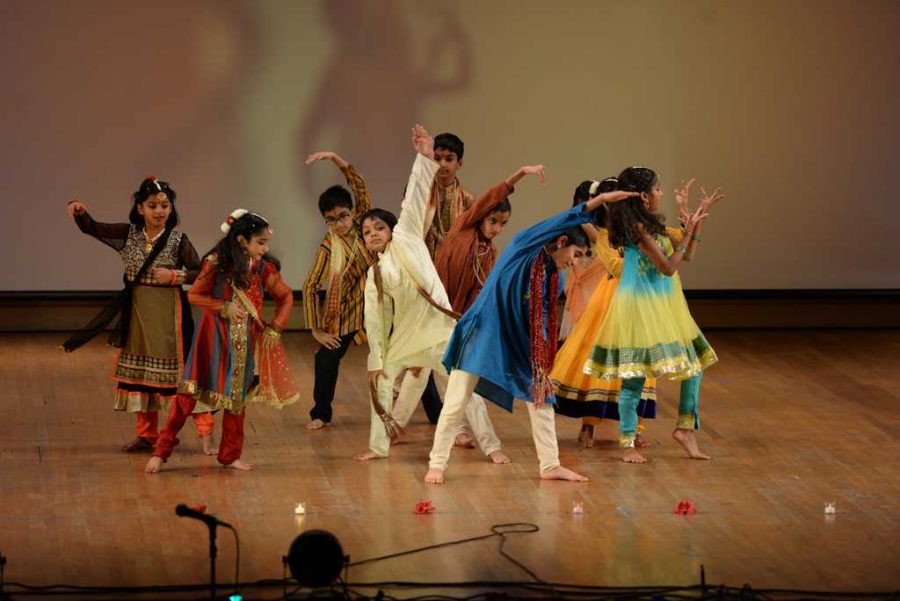This weekend, dancing shoes covered the floor of Bellefield Hall as Pitt students and community members feasted on Indian food and celebrated the Festival of Lights.
On Saturday, Nov. 14, 420 people gathered in Bellefield Hall Auditorium from 7 to 10:30 p.m. to watch musical performances and celebrate the first day of Diwali, a multi-day celebration that aims to cast out evil and bring joy into the lives of friends and family, according to senior Reena Naik, Hindu Students Council president.
HSC organized the two-day event to give an opportunity for students away from home to celebrate the holiday with friends and traditional Indian food.
“It’s really celebrating how good can always overcome evil, and celebrating happiness, joy, family and friends,” Naik said.
Diwali, also known as the Festival of Lights, is a religious holiday for Hindus, Jains, Buddhists and Sikhs. According to Hindu tradition, the holiday celebrates the return of Lord Rama, a great warrior king, after 14 years of exile from Ayodhya, an ancient city of India, and his defeat of Ravana of Lanka, an evil demon.
To celebrate, the people of Ayodhya lit rows of clay lamps, according to Society for the Confluence of Festivals in India. According to Sikh tradition, Diwali is a celebration of the return of the sixth guru from captivity. For Jains, the holiday recognizes the life and the nirvana of Lord Mahavira, who established the system of dharma that the Jain religion follows.
Strings of lights hung above the packed auditorium as audience members enjoyed musical performances from cultural dancing and singing groups across campus. The audience erupted into laughter or sang along when the performances made a reference to Bollywood, the Hindi language film industry. A French flag hung over the balcony to show solidarity, while an Indian and an American flag represented the blending of the two cultures.
The performances highlighted the diversity of talents and beliefs at Pitt and in the community by showcasing a variation of performances from traditional bhangra dancing, to a cappella, to beatboxing.
Because many people are not familiar with South Asian culture, the performances featured the diversity of the community in a vivid, exciting way, Naik said.
Performers and audience members alike wore traditional Indian clothing to show their devotion to the holiday.
Though family is a central theme of Diwali, going home to celebrate is not always possible for students, like Sophomore Harshit Agarwal, who spent Diwali away from his family for the first time.
“I feel like to some extent [the feeling of being at home] was covered by this celebration because so many of my friends came, so many people I consider almost family came to the event and we all got to have a fun time,” Agarwal said.
For Agarwal, the business manager of HSC, the Diwali festival is important because it brings attention to the diversity of organizations at Pitt.
“A lot of the time, people don’t realize that, not just [at] the University of Pittsburgh but within the Pittsburgh community overall, there’s a very diverse community,” Agarwal said.
The different groups represented the many different subsets of the South Asian community that celebrate the holiday and welcomed students to mix traditional and contemporary styles of music and dance.
Traditional bhangra — a dance performed during the harvest season in Punjab, a state in Northern India — is a folk dance, but contemporary styles incorporate pop music into the dance mixes. In both of the bhangra dances, the groups incorporated current, popular music, according to sophomore Rhiya Khosla, a member of the Steel City Bhangra.
Through much of the dance, performers alternated feet as they jumped up and down, a traditional part of the bhangra dance. The energetic movements are a reflection of the fielding and harvest work of the citizens of Punjab.
“Specifically the Bangara is done during the harvest month to show all the wheat growing and grass moving,” Khosla said.
Junior Prerna Srinirason, a member of the dance group Squaad, created her group to practice traditional Indian dance with friends in a more relaxed atmosphere. Srinirason and her team decided in mid-September they wanted to perform, however the full sequence wasn’t complete until Friday night.
The group performed a tribute to Madhuri Dixit, a Bollywood star known for her acting and dancing in popular Indian movies, such as “Abodh,” “Tezaab” and “Ram Lakhan,” by performing a Bollywood-style dance to songs from her movies.
Srinirason said Diwali gives some of the highly competitive teams a night to perform without any pressure.
“It’s a great opportunity just to show your friends what you’re doing and for you to cheer for your friends, onstage and offstage, because what I really love about dancing for the Diwali show is every dance team is here,” Srinirason said.
Because people from so many religions and regions across India and Southern Asia recognize Diwali, there is no one way to celebrate, Srinirason said.
Although the holiday is rooted in a celebration of gods and goddesses, the performers focused on one another and the people in the audience instead of the holy figures.
“It’s like a home away from home is what this show is all about,” Srinirason said. “Being able to collectively see all your friends in one place and just celebrate it together.”


